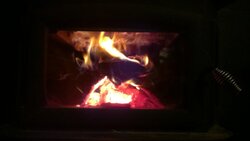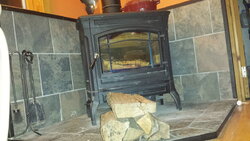I'm a guy who who made this assumption.....
So there I was,,,, 2 days after a fire (or maybe 3,,, it's been a while),,,,, looking at the forecast and seeing the end of the season.......
I got to business and cleaned the chimney, connector pipes, shoveled the vast majority of the contents of the stove out,,,, and vacuumed what remained.
It was close to me finishing the job when I noticed our very aged cat run up the steps next to the stove at a pace that was far above any average she regularly maintained....
My first instinct of course was to blame her for something,,,, but about that same time I wafted a scent that was very wrong,,,, it was a fraction of a second later that I noticed my shop vac sent a flame out the back that I would estimate to be between 4 and 5 feet

!
I obviously f-ed this deal up in a bad way by sucking up a hot coal that I didn't think should exist yet and putting it into a supercharged situation with all sorts of good fuel in the vac.
To summarize,,,, lots of things suck up stuff, there is a reason why some are called "ash vacs".
Don't make the same mistake I did!
!





